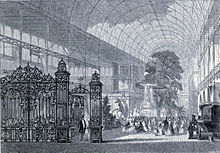Great Exhibition




The Great Exhibition, also known as the Crystal Palace Exhibition, was an international exhibition held in Hyde Park, London, England, from 1 May to 15 October 1851 and the first in a series of World's Fair exhibitions of culture and industry that were to be a popular 19th century feature.
The Great Exhibition of the Works of Industry of all Nations was organized by Prince Albert, Henry Cole, Francis Fuller, Charles Dilke and other members of the Royal Society for the Encouragement of Arts, Manufactures and Commerce as a celebration of modern industrial technology and design. It can be argued that the Great Exhibition was mounted in response to the highly successful French Industrial Exposition of 1844. Prince Albert, Queen Victoria's consort, was an enthusiastic promoter of a self-financing exhibition; the government was persuaded to form the Royal Commission for the Exhibition of 1851 to establish the viability of hosting such an exhibition.
A special building, nicknamed The Crystal Palace,[1] was designed by Joseph Paxton (with support from structural engineer Charles Fox) to house the show; an architecturally adventurous building based on Paxton's experience designing greenhouses for the sixth Duke of Devonshire, constructed from cast iron-frame components and glass made almost exclusively in Birmingham and Smethwick, which was an enormous success. The committee overseeing its construction included Isambard Kingdom Brunel. The massive glass house was 1848 feet (about 563 m) long by 454 feet (about 138 m) wide, and went from plans to grand opening in just nine months. The building was later moved and re-erected in an enlarged form at Sydenham in south London, an area that was renamed Crystal Palace; it was eventually destroyed by fire.[1]
Six million people – equivalent to a third of the entire population of Great Britain – visited the Exhibition. The Great Exhibition made a surplus of £186,000 which was used to found the Victoria and Albert Museum, the Science Museum and the Natural History Museum which were all built in the area to the south of the exhibition, nicknamed "Albertopolis", alongside the Imperial Institute.
The exhibition caused controversy at the time. Some conservatives feared that the mass of visitors might become a revolutionary mob,[citation needed] while radicals such as Karl Marx saw the exhibition as an emblem of the capitalist fetishism of commodities. Today the Great Exhibition has become a symbol of the Victorian Age, and its thick catalogue illustrated with steel engravings is a primary source for High Victorian design.
Exhibits
- Alfred Charles Hobbs used the exhibition to demonstrate the inadequacy of several respected locks of the day.
- Frederick Bakewell demonstrated a precursor to today's Fax machine.
- The Tempest Prognosticator, a barometer using leeches, was demonstrated at the Great Exhibition
- The America's Cup yachting event began with a race held in conjunction with the Great Exhibition.
- George Jennings designed the first public conveniences in the Retiring Rooms of the Crystal Palace for which he charged one penny.
Further reading
- Auerbach, Jeffrey A. The Great Exhibition of 1851: A Nation on Display, Yale University Press, 1999.
- Gibbs-Smith, Charles Harvard The Great Exhibition of 1851, 2nd edition, London: HMSO, 1981.
- Greenhalgh, Paul Ephemeral vistas: the expositions universelles, great exhibitions and world's fairs, 1851-1939, Manchester University Press, 1988
- Leapman, Michael. The World for a Shilling: How the Great Exhibition of 1851 Shaped a Nation, Headline Books, 2001.
- Dickinson's Comprehensive Pictures of the Great Exhibiton of 1851, Dickinson Brothers, London, 1854.[1]
See also
References
External links
- Prince Albert's speech of 1849, announcing "The Exhibition of 1851"
- "Memorials of the Great Exhibition" Cartoon Series from Punch
- Royal Engineers Museum Royal Engineers and the Great Exhibition
- "In Our Time"BBC radio programme discussing the Great Exhibition and its impact.
- Images from the catalogue on flickr.com
- Charlotte Bronte's account of a visit to the Great Exhibition
- Great Exhibition Collection in the National Art Library
